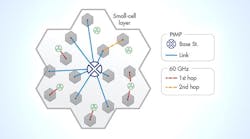Seeking to combine approaches for implementing 4G networks, many telecom companies are seeking the best of low-cost ownership, optimal range/capacity performance, and mitigation of line-of-sight (LOS) issues. The main technologies contending for use are point-to-multipoint (PtMP) and point-to-point (PtP) solutions from 2 to 80 GHz. Intracom Telecom covers the various wireless-backhaul technologies and their viability as a component in a multi-technology solution in the white paper, “Technology Synergies for Small-Cell Backhaul in 4G Networks.”
The paper details an evolutionary path for the adoption and deployment of LTE macro-cells initially. It then moves on to small cells equipped with LTE technologies, which are capable of future-upgrading to LTE-Advanced technologies. With the need to produce much denser small-cell grid networks in areas of economic interest, telecommunications organizations have the opportunity to open up “backhaul as a service” as a new profit stream. Unfortunately, there are challenges to incorporating the small-cell approach into the larger macro-cell-dominated structure. The main issues include hand-off and integrated small cells as a seamless component of the core network with economically viable small-cell technologies.
The white paper reviews the following technologies: sub-6-GHz, 18 to 38 GHz, 26/28 GHz, 60-GHz unlicensed bands, and 70/80-GHz light licensed bands. The main constraints for the upper-microwave and millimeter-wave spectrum technologies are generally LOS concerns. Short-hop concerns also arise over 60 GHz. Spectrum availability and congestion are concerns for the 18-to-38-GHz and 26/28-GHz technologies. Yet these concerns may not be significant compared to the issues faced by the limited-spectrum, interference-rife, and non-carrier-grade sub-6-GHz options—regardless of their cost and non-LOS advantages.
Because no single technology provides an optimal solution, the white paper suggests an efficient and synergistic solution using 26/28-GHz PtMP and 60-GHz PtP systems. In order to implement this multi-technology solution, it will be necessary to overlay PtMP technologies with an underlay of PtP technologies in dense areas with high data demand. To transform the backhaul architecture, the paper concludes that the industry will need to embrace fiber-optic infrastructure for transport/aggregation, radio backhaul for one or two hops, and shorter radio link distance with greater link density.
Intracom Telecom, 11360 Technology Circle, Duluth, GA 30097

